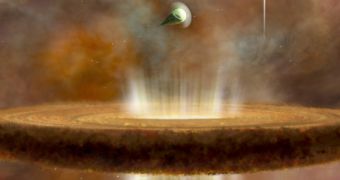An international collaboration of Canadian and American astronomers recently discovered that young protostars located less than 0.1 light-years away from massive, O-type stars cannot develop extrasolar planetary companions. The reason this happens is that intense radiations from the large celestial objects strip away their protoplanetary disks well before material within has a chance to coalesce into planets.
The new investigation was conducted using the Atacama Large Millimeter/submillimeter Array (ALMA) in Chile and focused on the famous Orion Nebula, a diffuse nebula also known as Messier 42 or NGC 1976. The object has been an astronomical target for many years, largely due to the fact that it lies just 1,350 light-years away.
The structure is home to a large number of young stars and protostars (or proplyds). The latter are objects that have collapsed from clouds of hydrogen gas and dust just recently and have not yet had a chance to grow to their fullest extent. While most of these young stars and proplyds will go on to develop exoplanets in orbit, some will not, primarily due to their unruly neighbors.
The new ALMA study found that proplyds located at a distance shorter than 0.1 light-years (965 billion kilometers or 600 billion miles) from massive O-type stars will not be able to develop exoplanets. The reason for this is that the remains of the gas clouds that spawned them, known as protoplanetary disks, will get destroyed by ultraviolet radiations released by their neighbors.
A protoplanetary disk contains gas, dust, and small particles that eventually clump up together to form larger gravitational nuclei. Within a few tens of millions of years, planets can be formed through the gradual accumulation of matter around such nuclei in the disk. In the case of proplyds with unruly companions, the disk is utterly destroyed within a few million years.
“O-type stars, which are really monsters compared to our Sun, emit tremendous amounts of ultraviolet radiation and this can play havoc during the development of young planetary systems,” says researcher Rita Mann. She was the lead author of a new paper detailing the study, which was published in the latest issue of the esteemed Astrophysical Journal.
“Using ALMA, we looked at dozens of embryonic stars with planet-forming potential and, for the first time, found clear indications where protoplanetary disks simply vanished under the intense glow of a neighboring massive star,” adds the investigator, who holds an appointment as an astronomer with the National Research Council of Canada, in Victoria.
This is just one of the first complex studies to be conducted with ALMA, which is the most advanced radio telescope in the world. In the future, experts hope that its capabilities will help determine exactly how common solar system-like star systems really are. What has been made abundantly clear already is that the neighborhood of an O-type star is no place to raise an exoplanet.
ALMA is operated by the European Southern Observatory (ESO) on behalf of Europe and the National Radio Astronomical Observatory (NRAO) on behalf of the United States. Numerous other international partners are involved in this effort as well.

 14 DAY TRIAL //
14 DAY TRIAL //